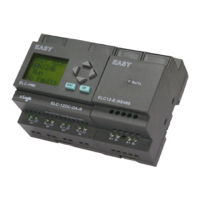34
34
34
34
C
C
C
C hapter
hapter
hapter
hapter 3
3
3
3 Programming
Programming
Programming
Programming xLogic
xLogic
xLogic
xLogic
Note
Note
Note
Note :
:
:
:
Only the new ELC-12 series &Upgraded ELC-18 CPU supports the programming via HMI panel key .
Getting
Getting
Getting
Getting started
started
started
started with
with
with
with xLogic
xLogic
xLogic
xLogic
Programming refers to creating a circuit program from the xLogic Basic module.
In this chapter you will learn how to use xLogic to create the xLogic circuit programs for your application.
xLogic Soft is the xLogic programming software that you can use on your PC to
quickly and easily create, test, modify, save and print the circuit programs. The topics in this manual,
however, relate only to the creation of circuit programs on the actual xLogic Basic module. The programming
software xLogic Soft contains extensive online help.
A small example in the first part of this chapter introduces the operating principles of xLogic :
● You will learn the meaning of two basic terms, namely the connector and the block.
● As the next step, you will create a circuit program based on a simple conventional circuit.
● Lastly, you will enter this program directly in xLogic.
It will take you only a few pages of this manual to store your first executable circuit program in the xLogic unit.
With suitable hardware (switches etc.), you will then be able to carry out initial tests.
3.1
3.1
3.1
3.1 Connectors
Connectors
Connectors
Connectors
xLogic is equipped with inputs and outputs
Example of a configuration with several modules:
Each input is identified by the letter I plus a number. When you look at xLogic from the
front,you can see the input terminals at the top. Only analog modules (PT100 and 0 … 20mA
input ) have the inputs at the bottom.
Each output is identified by the letter Q plus a number ( ELC-E- AQ: AQ plus number). In the
figure, you can see the output terminals at the bottom.
Note
xLogic can recognize, read and switch the I/O of all expansion modules regardless of their type.
The I/Os are not presented in the installation order of the modules , it rests with the address of
the expansion modules . For example the first input of the expansion module with the

